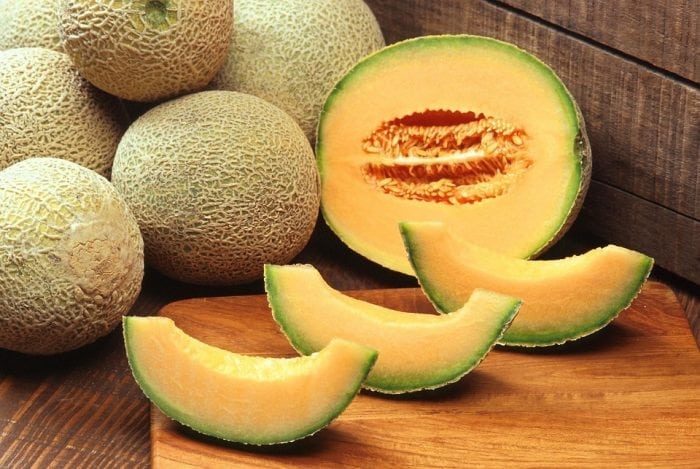
A study conducted by food microbiologists from National University of Singapore and Korea National University of Transportation shows that blue light emitting diodes (LEDs), particularly of wavelengths 405 and 460 nm, have an antibacterial effect against deadly bacteria on fresh fruits. The study tested the hypothesis against Listeria monocytogenes and Salmonella spp. that are two prevalent pathogens linked to foodborne illness outbreaks in cantaloupes. The aim of this technology was to fulfill the need for an additional hurdle to refrigeration for the preservation of cantaloupe during storage and transportation from farm to local grocery stores.
Cantaloupes have complex netted rinds that harbor bacterial pathogens such as L. monocytogenes and Salmonella spp. L. monocytogenes can survive at refrigerated temperatures, and its incubation period (time from the moment of exposure until symptoms appear) can last as long as 70 days. Symptoms include fever, muscle ache, and gastrointestinal problems that can be life-threatening in children, pregnant women, and the elderly. Salmonellosis is one of the common causes of diarrhea globally and other symptoms include vomiting, nausea, abdominal cramps, and fever. The incubation period ranges from several hours to two days, while the symptoms can last for up to seven days.
Conventional washing and antibacterial treatments are not always effective against bacterial pathogens present on the surface of cantaloupes. This is a source of threat because of the issue of transfer of bacteria to fresh-cut pieces of cantaloupe. Hence, despite safety measures in place, cantaloupe-related outbreaks have been in the spotlight in recent times. A tragic case of bacterial pathogen contamination came to light when cantaloupes were recalled in Feb 2018 in Australia. Subsequent investigation revealed that cantaloupes were contaminated with L. monocytogenes and resulted in seven deaths and one miscarriage (1). Earlier in April of this year, a Salmonella outbreak infected 77 people and 36 people were hospitalized. The outbreak was traced back to packages containing pre-cut watermelon, honeydew melon, cantaloupe, and mixed fruit according to the Centers for Disease Control and Prevention (CDC) (2).
The principle behind the antibacterial effect of blue LEDs is attributed to the process of photodynamic inactivation (PDI). PDI is a non-thermal intervention technology that inactivates microorganisms by the production of reactive oxygen species (ROS). The ROS are produced when endogenous photosensitizers (present within the microorganisms) are excited by light of suitable wavelength. LEDs have been the preferred light source because of its compact design, cost-effectiveness, higher life expectancy, and ability to be wavelength specific (3). Previous studies on the antibacterial application of blue LEDs on buffer solutions concluded that blue light-emitting diode (LED) of wavelengths 405 and 460 nm has higher antibacterial effects than other wavelengths of 521 nm and 642 nm (4).
Though bacterial cells have endogenous photosensitive components, PDI using exogenous photosensitizers have increased antibacterial effect as shown by other researchers (5). So in this study, sodium chlorophyllin copper solution (Na-Chl) a water-soluble food additive (E14), approved as generally recognized as safe by the US Food and Drug Administration was used as an exogenous photosensitizer. Sets of samples were immersed in Na-Chl solution before 405 and 460 nm LED exposure. Experiments were conducted at temperatures (4 and 20 °C) the cantaloupes would be exposed to during storage and transportation.
After LED exposure for 48 hours, various treatment conditions resulted in the death of 90-99.9% of the initial bacterial population on the cantaloupe rinds. It was seen that the antibacterial effect of 405 and 460 nm LEDs were similar against L. monocytogenes. But in the case of Salmonella spp., PDI using 405 nm LED had a greater antibacterial effect than PDI using 460 nm LED. It is likely that this was because of variations in the composition of endogenous photosensitizers in L. monocytogenes and Salmonella spp. Further, the time (mean value) taken to kill 90% of the initial bacterial population was calculated to compare the effectiveness of the treatments. It was found to be lower in PDI using 405 nm LED than 460 nm LED illumination. PDI using LED alone and PDI using LED along with external photosensitizer had similar antibacterial effects suggesting that addition of external photosensitizers did not influence the treatment in cantaloupes.
The results of this study suggest the potential of blue LED technology against deadly bacteria on cantaloupe, and, thus, researchers believe that this technology could minimize the risk of salmonellosis and listeriosis linked to fresh cantaloupe. Future research conducted with real-time conditions will determine the course of application for this prospective intervention technology.
These findings are described in the article entitled Inactivation of Listeria monocytogenes and Salmonella spp. on cantaloupe rinds by blue light emitting diodes (LEDs), recently published in the journal Food Microbiology. This work was conducted by Sherrill Wesley Josewin from the National University of Singapore, Min-Jeong Kim from the Korea Food Research Institute, and Hyun-Gyun Yuk from the Korea National University of Transportation.
References:
- https://www.who.int/csr/don/09-april-2018-listeriosis-australia/en/
- https://www.cdc.gov/salmonella/adelaide-06-18/index.html
- D’Souza, C., Yuk, H. G., Khoo, G. H., & Zhou, W. (2015). Application of Light‐Emitting Diodes in Food Production, Postharvest Preservation, and Microbiological Food Safety. Comprehensive Reviews in Food Science and Food Safety, 14(6), 719-740.
- Ghate, V. S., Ng, K. S., Zhou, W., Yang, H., Khoo, G. H., Yoon, W. B., & Yuk, H. G. (2013). Antibacterial effect of light emitting diodes of visible wavelengths on selected foodborne pathogens at different illumination temperatures. International journal of food microbiology, 166(3), 399-406.
- Luksiene, Z., & Paskeviciute, E. (2011). Novel approach to the microbial decontamination of strawberries: chlorophyllin‐based photosensitization. Journal of applied microbiology, 110(5), 1274-1283.









